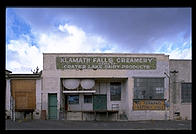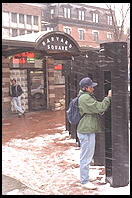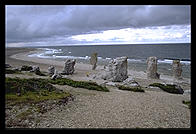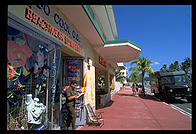

|
Chapter 14: ecommerce |
 "Electronic commerce" conjures up visions of product catalog sites
and shopping baskets, things that were passé back in 1995.
Why then a chapter on ecommerce?
"Electronic commerce" conjures up visions of product catalog sites
and shopping baskets, things that were passé back in 1995.
Why then a chapter on ecommerce?
First, because so few people are doing it right. A friend of mine said that he wouldn't buy an airplane ticket from the United Airlines Web site. He wasn't paranoid about his credit card number being compromised. Drawing an inference from their sluggish and badly programmed Web service, he didn't believe that his reservation would be made or a ticket issued.
Second, because people are spending obscene amounts of money to do trivial things. Sometimes the money is spent on buying packaged junkware and then on figuring out how to debug/integrate it. Sometimes the money is spent on madly writing, compiling, and debugging Java programs that replicate capabilities already present in sets of Perl or Tcl scripts three years ago.
Finally, because even a bland ecommerce site may occasionally blossom into an interesting site with community or Web service angles.
 Curious to see if some intervening months had sufficed for United
Airlines to get their programming act together, I tried to buy a ticket
on-line on April 22, 1998. Even at 2:00 am, the site was sluggish, to be
sure, but I managed to find a $300 San Francisco/Boston round-trip.
When I tried to buy the ticket, I got a server error message with
instructions to try later. A few hours later, the site was operational
but the $300 fare was no longer listed. I called United and they said
they'd be happy to sell me a ticket, but it would be $1900. The $300
fare had only been available earlier in the day. When I noted that the
only thing that had prevented me from buying the ticket was their broken
site and would they consider honoring the fare, they said I should call
their customer relations number, which I did. I reached a recording
that said "32-10 you have dialed an invalid number".
Curious to see if some intervening months had sufficed for United
Airlines to get their programming act together, I tried to buy a ticket
on-line on April 22, 1998. Even at 2:00 am, the site was sluggish, to be
sure, but I managed to find a $300 San Francisco/Boston round-trip.
When I tried to buy the ticket, I got a server error message with
instructions to try later. A few hours later, the site was operational
but the $300 fare was no longer listed. I called United and they said
they'd be happy to sell me a ticket, but it would be $1900. The $300
fare had only been available earlier in the day. When I noted that the
only thing that had prevented me from buying the ticket was their broken
site and would they consider honoring the fare, they said I should call
their customer relations number, which I did. I reached a recording
that said "32-10 you have dialed an invalid number".
 Ultimately I did reach customer relations where they also refused to
honor the fare, mumbling something about how the Web was just an
experimental thing anyway. In one transaction, United had managed to
simultaneously demonstrate incompetence and unwillingness to take
responsibility for its incompetence.
Ultimately I did reach customer relations where they also refused to
honor the fare, mumbling something about how the Web was just an
experimental thing anyway. In one transaction, United had managed to
simultaneously demonstrate incompetence and unwillingness to take
responsibility for its incompetence.
Can you learn from United's mistakes? Yes. Before you set up an
ecommerce site, decide (1) whether you are serious about building a
working service, and (2) whether you are going to take responsibility for
your programming and administration mistakes.
 Though one of my leitmotifs is "packaged software probably won't solve
your problem", accounting software is an exception. Web services
tend to be new and varied. It would be a hopeless fantasy for me to go
down to CompUSA and try to buy a birthday reminder server that
accomplishes what the custom Tcl/SQL scripts at http://www.arsdigita.com/remindme/
do. But if ArsDigita, LLC wanted to keep track of invoices, payments,
and taxes, it would be insane to write an accounting system from scratch.
Our Web publishing goals aren't shared by too many other people but our
accounting problem is the same as that of any other business.
Though one of my leitmotifs is "packaged software probably won't solve
your problem", accounting software is an exception. Web services
tend to be new and varied. It would be a hopeless fantasy for me to go
down to CompUSA and try to buy a birthday reminder server that
accomplishes what the custom Tcl/SQL scripts at http://www.arsdigita.com/remindme/
do. But if ArsDigita, LLC wanted to keep track of invoices, payments,
and taxes, it would be insane to write an accounting system from scratch.
Our Web publishing goals aren't shared by too many other people but our
accounting problem is the same as that of any other business.
Thus at the end of the day, you're going to have a custom-developed Web application talking to a standard accounting system of some sort. If the accounting system is powerful and running out of the same RDBMS installation as the Web site, then you might well not need to confront any of the allegedly tough ecommerce technology decisions.
 In the past four years, a particular kind of ecommerce site development
project seems to cross my desk repeatedly. A manufacturing company has
been selling to retailers for decades. The Web site will be the first
time that they've sold directly to customers. Customers will get the
ability to order semi-custom products and the factory will get real-time
access to information about what customers want.
In the past four years, a particular kind of ecommerce site development
project seems to cross my desk repeatedly. A manufacturing company has
been selling to retailers for decades. The Web site will be the first
time that they've sold directly to customers. Customers will get the
ability to order semi-custom products and the factory will get real-time
access to information about what customers want.
An obvious first cut at the problem involves three database installations:
Suppose, however, that the Web server needs a lot of data from the factory tables before it can offer delivery information. It is possible to keep copies of the necessary factory tables in the Web server's RDBMS. Every time an update or insert is made on the factory RDBMS, the transaction is duplicated on the Web server RDBMS. This is called database replication and companies like Oracle produce software to facilitate replication. However, you have to budget extra time and money to develop and maintain a replication strategy. So you might consider eliminating the RDBMS next to the Web server and configuring the Web server program to make an encrypted connection to the factory RDBMS.
Suppose that you are quickly turning out custom goods. You can't wait for batches of orders to be sent to the factory because products are supposed to be built and shipped on the same day as orders placed before 2:00 pm. This means that the factory RDBMS must have rapid access to the relevant tables from the Web server RDBMS. Again, you have the option of replication or eliminating the factory database installation and having the factory client programs talk directly to the Web server RDBMS.
Suppose that you want to offer customers the option to "bill the same credit card as on your last order, ending in 4561." In that case you either need to keep the old credit card numbers yourself or have some means of communication between your database and your transaction vendor (bank).
Suppose that your accounting system can run the credit card numbers. In that case, you will probably want to eliminate the RDBMS at the bank and tightly couple the Web site to whatever RDBMS installation is running the accounting system.
There are no correct answers to the questions of "how many RDBMS
installations and where are they" but you need to address them
nonetheless.
Step 4: Lifetime Customer Value Management
 Companies that are selling direct for the first time will immediately
realize that they now have access to their dream data. They can figure
out, down to the individual consumer, who is buying what and how often.
About two days after the business folks realize this, they will turn to
the nerds and say "Build us a lifetime customer value management
system."
Companies that are selling direct for the first time will immediately
realize that they now have access to their dream data. They can figure
out, down to the individual consumer, who is buying what and how often.
About two days after the business folks realize this, they will turn to
the nerds and say "Build us a lifetime customer value management
system."
The "lifetime" in the above phrase reflects the fact that you have to engineer the system to track particular customers' activities over many years. As soon as Joe Smith shows up on the site, you need to know how many times this person has placed an order, returned a product, demanded a refund, come to the site and not ordered, etc.
The engineering in a system like this is a straightforward matter of SQL
tables and Web scripts. What's hard are the business rules. Here are
some examples:

As a Web developer, I don't think there are customer value management technical issues that are distinct from those associated with personalization on non-commercial sites. But as a publisher or service designer, you should at least be aware that you'll have to spend a few weeks thinking about what rules to implement.
 MIT Press is a publisher of books and academic journals. Since 1993,
they'd been putting progressively more catalog info and content on their
Web site, which was developed and maintained by Terry Ehling. She
originally worked part-time but by 1996 being webmistress was a
full-time job. In 1996, Terry came to me with the following goals for
her Web site (http://mitpress.mit.edu):
MIT Press is a publisher of books and academic journals. Since 1993,
they'd been putting progressively more catalog info and content on their
Web site, which was developed and maintained by Terry Ehling. She
originally worked part-time but by 1996 being webmistress was a
full-time job. In 1996, Terry came to me with the following goals for
her Web site (http://mitpress.mit.edu):
Installing and maintaining an RDBMS is a fair amount of work. If we were going to all that trouble to make the Web service work, it seemed like a good idea to eventually run production and accounting from the same database. Of course, what seems like a good idea to an engineer doesn't always seem like a good idea to a business person. The management of the Press wasn't ready to consider fundamental changes to the rest of the business.
One side effect of this decision was that it got us out of the on-line credit card verification business. We'd just have to pipe credit card numbers along with orders to the existing accounting system and let those folks handle them the way they handled other credit card orders. If a customer gave us a bad number, we'd email him.
 A primary purpose of the Web site was to facilitate on-line shopping.
Everyone else on the Internet at the time was implementing shopping
basket systems. I had built some for clients in 1995 but by 1996 had
soured on the idea. It wouldn't have been a horrible concept if every
site used the same shopping cart system. But each site had its own user
interface. Why should you have to learn how to "check out" when all you
wanted was one book?
A primary purpose of the Web site was to facilitate on-line shopping.
Everyone else on the Internet at the time was implementing shopping
basket systems. I had built some for clients in 1995 but by 1996 had
soured on the idea. It wouldn't have been a horrible concept if every
site used the same shopping cart system. But each site had its own user
interface. Why should you have to learn how to "check out" when all you
wanted was one book?
I argued for an invisible shopping cart. A user would click on a product and get an order form. After submitting it with shipping address and credit card number, a magic cookie would be written back to his browser. The user would be offered the opportunity to continue shopping. If he clicked on an "order" link again, he'd be offered the opportunity to add the item to his previous order. The system would degrade gracefully. If the user's browser didn't adhere to the Netscape magic cookie spec, he'd still be able to place orders for products, but it would be a little more cumbersome. If an order had already been transmitted to the old Data General Nova system then the user wouldn't be offered the "add to old order" option. If the user quit his browser and restarted, he wouldn't get the "add to old order" option.
We decided to go for the invisible cart. Orders initiated the previous day would be transmitted in a batch from the RDBMS to the legacy system every morning at 7:00 am. That meant a user had between 7 and 31 hours to complete an order using the invisible cart.
 It turns out that working in the publishing world is a programmer's
dream. The industry has been forced for many years to key everything by
the International Standard Book Number (ISBN). So there are very few
thorny data modeling issues.
It turns out that working in the publishing world is a programmer's
dream. The industry has been forced for many years to key everything by
the International Standard Book Number (ISBN). So there are very few
thorny data modeling issues.
To avoid typing 6000 book titles, we got a text file dump of the data in
the Data General Nova system. Then we wrote some Perl scripts to
convert these into SQL inserts and fed the whole batch to Illustra's
Unix shell client. We wrote some AOLserver Tcl scripts to
semi-automatically transfer over book jacket images and long
descriptions from files on the old Web server. We decided not to store
book and journal images in the RDBMS. Instead, we kept a Unix file
system directory for each catalog item. For books, the AOLserver Tcl
script would look in the directory for cover-sm.gif or
cover-sm.jpg. If present, it would be displayed on the
book catalog page (see http://mitpress.mit.edu/book-home.tcl?isbn=0262650398).
If not, we'd serve a page with a slightly different design (see http://mitpress.mit.edu/book-home.tcl?isbn=0262560631).
books table for basic title and description
for the ISBN key in the URL.
reader_comments table to pull out reader
comments for display right on the page.
books table again to find related items, such
as a paperbound version of the same title.
books table to
find other books by the same author(s).
Ben eventually figured it all out and designed a beautiful looking site with stacked tables. The first table contained the information from the first three RDBMS queries and the last contained the "books by the same author" content plus the page footer. It was fast and looked great. Despite my general blame-the-graphic-designer philosophy, I had to admit that overall it was a huge improvement.
I went over to mitpress.mit.edu just now (August 10, 1998) to make sure of exactly where in the page Ben had put in the split table. I found that the site has been redesigned a bit since that meeting. Each book page is a navigation header plus one big HTML table so that the user stares at a blank screen while Illustra grinds. Oh well....
 What's the bottom line? Site traffic has grown steadily, partly because
of new content developed by Terry Ehling, Marney Smyth, and Ken Overton
(MIT Press's current Web staff), but also because the catalog
information is deeper and more complete. The product catalog turned out
to be a failure as a community Web site; only a handful of readers
commented on books. There is no obvious technical reason for this
failure since the comment facility is similar to that offered by
amazon.com, where readers engage in lively debate (check the comments
for Database Backed Web Sites, at http://www.amazon.com/exec/obidos/ISBN=1562765302).
It can't be explained by a total lack of reader interest since nearly
1000 readers per month are signing up to be notified of new books in various
categories.
What's the bottom line? Site traffic has grown steadily, partly because
of new content developed by Terry Ehling, Marney Smyth, and Ken Overton
(MIT Press's current Web staff), but also because the catalog
information is deeper and more complete. The product catalog turned out
to be a failure as a community Web site; only a handful of readers
commented on books. There is no obvious technical reason for this
failure since the comment facility is similar to that offered by
amazon.com, where readers engage in lively debate (check the comments
for Database Backed Web Sites, at http://www.amazon.com/exec/obidos/ISBN=1562765302).
It can't be explained by a total lack of reader interest since nearly
1000 readers per month are signing up to be notified of new books in various
categories.
The invisible shopping cart system and sending orders to the legacy system turned out to work just fine. The site has processed many thousands of orders without imposing an undue burden on folks at MIT Press.
The AOLserver/Illustra combination turned out to require minimal maintenance. MIT Press did not have to hire full-time computer science geeks, database administrators, or Unix system administrators. They've been able to concentrate almost all of their efforts on developing new Web content.
Should anyone be impressed by these results?
Yes! We put about four person-weeks of programming into the site and it has the same functional capabilities as amazon.com circa 1997 (amazon had more than 10 full-time programmers). We did not waste server resources with CGI scripts that reopened the database and hence MIT Press did not have to invest $150,000 in a monster Unix box. We did not use an application server or otherwise invest programmer resources in layers of abstraction to insulate the site from Illustra-specific SQL. Consequently, a variety of people without formal computer science backgrounds have been able to edit and adapt the AOLserver Tcl scripts to their needs, extend the administration section, or get me to swoop in and make the occasional surgical change.
It wouldn't be so impressive if there weren't so many folks out there who spend $1 million on infrastructure, packaged software, and software development before they can take their first order.
Each journal needs to have institutional, individual, and student subscription rates. Back issue prices need to be similarly trifold. Finally, there are separate prices for back issues that are "double issues". In a turnkey catalog system, you'd probably have to represent one journal as nine separate products in order to offer these nine separate prices. That would mean MIT Press personnel would have to change journal titles or editorial board info in nine separate database rows.
Because we did not use packaged software, we were able to program in lots of shortcuts on the admin side. The administration home page for a book has the stuff you'd expect from a commercial software package, e.g., links to all the orders for the book and the readers who've expressed interest in the book. But it also has one-click catalog maintenance shortcuts, e.g., "Record this title as being out of print" or "Change the price by editing the old price here and hitting carriage return."
It turns out that banks never wanted to do anything like this. They left credit card processing to a handful of third-party companies such as First Data (http://www.firstdata.com), NOVA (http://www.novainfo.com), and Paymentech (http://www.paymentech.com). When a consumer's card gets swiped at the supermarket, the little terminal talks to NOVA, for example, and NOVA talks to the consumer's bank and the supermarket's bank.
Okay, so now the obvious thing would be for each of these third-party companies to park a transaction server on the Internet. Then a merchant can choose to contact NOVA or Paymentech by sending encrypted packets rather than dialing up. But it apparently turned out that even NOVA and Paymentech didn't want to wade into the public Internet.
 The most direct and obvious way to bill credit cards is to stick a modem
on the back of your Unix machine and have it dial up a credit card
processor such as First Data. Your Web site looks to the world's
banking system just like the pizza shop around the corner. If you want
fast connections, you can get a frame relay or ISDN line to the
processor. If you don't want to figure out the protocol that is being
used by the little terminal in the pizza shop, you can pick up some
software such as HKS's CCVS (see
http://www.hks.net)
for about $1000.
The most direct and obvious way to bill credit cards is to stick a modem
on the back of your Unix machine and have it dial up a credit card
processor such as First Data. Your Web site looks to the world's
banking system just like the pizza shop around the corner. If you want
fast connections, you can get a frame relay or ISDN line to the
processor. If you don't want to figure out the protocol that is being
used by the little terminal in the pizza shop, you can pick up some
software such as HKS's CCVS (see
http://www.hks.net)
for about $1000.
One downside of this approach is that you'll be forced to maintain a
highly secure Web server/database containing customer credit card numbers.
 For people who don't want to stick modems on the backs of their
computers, there are companies like CyberCash (http://www.cybercash.com),
ICOMS (http://www.icoms.com),
and Verifone (http://www.verifone.com)
that operate transaction servers that then talk to First Data, NOVA, or
Paymentech (that then talk to the banks' computer systems).
For people who don't want to stick modems on the backs of their
computers, there are companies like CyberCash (http://www.cybercash.com),
ICOMS (http://www.icoms.com),
and Verifone (http://www.verifone.com)
that operate transaction servers that then talk to First Data, NOVA, or
Paymentech (that then talk to the banks' computer systems).
CyberCash and ICOMS exemplify two very different Web service architectures. In the CyberCash case, the merchant server collects credit card numbers from consumers. The merchant server then talks to CyberCash to find out if the card is valid and bill the card. This lets the merchant offer the customer options like "Use the same credit card as your last order?" If the merchant becomes unhappy with CyberCash, this architecture lets the merchant switch transaction vendors without consumers ever knowing.
What's the downside of the CyberCash architecture? It imposes a
programming and security burden on the merchant. For example, if the
merchant's programmers aren't competent, customers may get billed for
orders that are never entered or shipped. Alternatively, orders may get
entered for customers whose credit cards failed authorization. Customer
credit card numbers may reside in the merchant database. So if the
merchant's database is compromised, not only can the intruder determine
who purchased what, but he will get a big table of credit card numbers
as well.

The ICOMS architecture assumes that the merchant is incompetent to write programs. A merchant can only embed "digital offers" (little blocks of HTML) in static .html Web documents. As soon as the customer wants to add something to a shopping basket or place an order, the digital offers bounce the customer over to a transaction server run by ICOMS. ICOMS will eventually notify the merchant server that an order was placed. The big advantage of ICOMS is that you don't have to be constantly paranoid about security. Your customers' credit card number might be compromised, but it will be someone else's fault!
A big disadvantage of the ICOMS architecture is that your overall Web service may become unreliable and slow due to factors beyond the merchant's control. For example, under the CyberCash architecture, even if the merchant's server couldn't reach CyberCash, it could be programmed to continue to take orders and then process them in a batch when CyberCash became reachable again. But with ICOMS, the customer can't even type in a credit card numbers or address if ICOMS is down. Furthermore, it is the ICOMS server that offers customers a "use the same credit card as before" option. So the consumer becomes tied to the ICOMS network and not to the merchant. Finally, you might not be able to achieve your user interface and customer service pages goals with the ICOMS-style architecture.
If you're tempted to use the ICOMS architecture and let another server handle the collection of payment and shipping information, why not go whole-hog and let another server handle the distribution of sales information as well? If your payment pages don't need a custom flow then maybe your whole shop doesn't need a custom flow. You can go over to store.yahoo.com, configure a shop using a Web browser, and pay them $100 a month to present offers and collect orders for you. Yahoo Store offers an interesting comment on the state of ecommerce:
"Although Yahoo! Store supports real-time credit card authorizations through Cybercash, we do not recommend it for most merchants. ... using Cybercash tends to be more trouble than it is worth.
-- http://store.yahoo.com/vw/cybercash.html (August 10, 1998)
 Some of these listings are deceptive in that they are really front-ends
to more basic services. If you don't want to grapple with CyberCash's
CGI scripts, there are a few dozen ISPs and Web development companies
who will sell you simpler less-general scripts. However, it is hard to
tell from reading their Web sites that what they've developed is a
100-line Perl script and not a complete system to compete with
CyberCash or Verifone.
Some of these listings are deceptive in that they are really front-ends
to more basic services. If you don't want to grapple with CyberCash's
CGI scripts, there are a few dozen ISPs and Web development companies
who will sell you simpler less-general scripts. However, it is hard to
tell from reading their Web sites that what they've developed is a
100-line Perl script and not a complete system to compete with
CyberCash or Verifone.
In the long run, the SET protocol could potentially bring the world
closer to the "consumers dealing with merchants dealing with banks as
peers on the Internet" model that you'd naively assume was the way
everything had always worked. However, if you're a Web publisher,
"potentially" and "long run" aren't very interesting ideas.
Furthermore, all of the payment APIs to which you can write code in 1998
claim to be SET-compliant. So if the great SET day ever arrives, you
might not have to change even one of your scripts.
An Extra Layer of Transactions
 Generally you can rely on the relational database management system
(RDBMS) sitting behind your Web service to handle transactions. You can
tell Oracle to "change all of these things and if any of them fail, then
undo all the changes and insertions that suceeded." Oracle is extremely
reliable at rolling back transactions but your Oracle system isn't
capable of rolling back a change on a non-cooperating foreign
system, e.g., CyberCash's server or the First Data computer system into
which your Web server dialed.
Generally you can rely on the relational database management system
(RDBMS) sitting behind your Web service to handle transactions. You can
tell Oracle to "change all of these things and if any of them fail, then
undo all the changes and insertions that suceeded." Oracle is extremely
reliable at rolling back transactions but your Oracle system isn't
capable of rolling back a change on a non-cooperating foreign
system, e.g., CyberCash's server or the First Data computer system into
which your Web server dialed.
Suppose that you decide to implement the following architecture:
 The obvious way to implement an ecommerce system is the following:
The obvious way to implement an ecommerce system is the following:
There are potentially many ways of getting around this problem, but I think the simplest approach instead is to
Our response? Too boring. We specialize in community Web sites and grand public services like www.scorecard.org that satisfy our bloated egos when the sites are featured on network TV news.
"We want you to process a few million orders in the next two years. At around $50 each. We have the budget to make this work."
Oh, well, gee, that sounds like an interesting challenge after all...
 We decided early on that we didn't want to talk directly to the card
processors via modem. We needed to have a reliable IP connection to
talk to Web customers so why not use that to talk to the banking system
as well? We'd have to engineer defensively to handle the times when the
Internet gateway to the credit card system was unavailable, but we'd
also be eliminating two potential points of failure: the modem and the
phone line.
We decided early on that we didn't want to talk directly to the card
processors via modem. We needed to have a reliable IP connection to
talk to Web customers so why not use that to talk to the banking system
as well? We'd have to engineer defensively to handle the times when the
Internet gateway to the credit card system was unavailable, but we'd
also be eliminating two potential points of failure: the modem and the
phone line.
Another motivation behind this decision was that we expected to be able to avoid keeping cleartext credit card numbers in our database if we used one of these fancy Internet commerce gateway services.
We looked at the vPOS system from VeriFone and rejected it immediately because it only works with Microsoft Internet Information Server (we don't know anyone who understands NT well enough to run a Web service from Windows NT), Netscape Enterprise Server (we aren't willing to suffer with Netscape's programming tools, such as LiveWire), and Oracle Web Server (our code library is in AOLserver Tcl).
We looked at http://www.cybercash.com. It offers three options for building "your on-line store":
Due to a combination of bad programming and user interface design on the CyberCash site plus sluggish customer service personnel, we weren't able to even download the software for 48 hours. The downloaded kit was a gzipped Unix tar file, but it bore no extension so it took a bit of Unix expertise to (1) figure out what kind of file it was, and (2) rename it to foobar.tar.gz and gunzip it.
At this point, we had to decide whether to use the Perl interface or the C library. In general, we prefer to use interpreted languages for Web software development. However, since we were building the entire site in AOLserver Tcl, it seemed tasteless to maintain some of the pages in Perl CGI. Jin spent a night writing a 200-line C program (see http://www.photo.net/wtr/thebook/cybercash.c).
The CyberCash API consists of exchanging key-value pairs.
There is really only one basic C procedure that one needs to call and
Jin's code is a bridge between the CyberCash key-value data structure
and AOLserver's ns_set data structure. All the interesting
information about the API is in Appendix B of
http://www.cybercash.com/cybercash/merchants/docs/dev.pdf.
To the extent that CyberCash is tricky, it is mostly because the credit card world is archaic and tricky. There are two fundamental steps in processing a credit card order. The first step is authorization. The merchant gives the processor a card number, expiration date, name on card, street address, and zip code. The processor is fundamentally checking that the card number is valid and that the cardholder has sufficient credit to handle the amount authorized. Given the religious zeal with which merchants collect your card expiration dates, you'd think that processors did something clever with this. In fact all they do is make sure that it is a date in the future. So if a consumer's card expires in 06/00 and he gives you 01/00, First Data will not reject the transaction. The address verification service (see below) is purely to help merchants assess the risk of sending out a product and then later finding out that the credit card number was purloined. The processor says "Zip code matched but address did not" or "Nothing matched". The merchant has to decide whether or not to take the risk of shipping the good.
The second step in processing a credit card order is settlement or "capture." With a hard good, the merchant would typically authorize when it gets an order and capture when it ships the product. With a soft good, e.g., the sale of access to a Web service or document, the merchant would typically capture immediately after authorization.
Complicating matters somewhat is the fact that processors try to conserve their network and server resources by coercing merchants into performing settlements in batches of five or more. A merchant can kick CyberCash into autosettlement mode whereby Cybercash periodically sweeps its database to find transactions that are authorized and marked for settlement. So the hard goods merchant's two basic operations become "mauthonly" (to authorize; done when order is received) and "postauth" (to mark for settlement; done when good is shipped). A soft goods merchant can put Cybercash into auto-mark, auto-settle mode whereby authorized transactions are immediately marked for settlement.
 What's great about CyberCash is that it is so centered on the merchant's
order ID. We give CyberCash a card number and a unique order ID and
from then on we can do all of our transactions merely by referencing
this order ID. These transactions include "void" (halt the settlement
process), "return" (refund a consumer's money for a settled
transaction), and "card-query" (get the full cleartext card number back
for a particular order).
What's great about CyberCash is that it is so centered on the merchant's
order ID. We give CyberCash a card number and a unique order ID and
from then on we can do all of our transactions merely by referencing
this order ID. These transactions include "void" (halt the settlement
process), "return" (refund a consumer's money for a settled
transaction), and "card-query" (get the full cleartext card number back
for a particular order).
Another nice thing about Cybercash is that they have a full Web site
where a merchant can go to review all the orders, do refunds, run cards
one at a time, etc.
 Our brilliant scheme would founder if Cybercash did not keep order data
around for a long time. It might take a customer 10 days to receive a
good and 45 days to decide that he didn't like it and send it back. We
don't want to have to ask him for his card number again. If it took us
more than seven days to mark an authorized transaction for settlement then
the cardholder's bank might reject the settlement and we'd have to
reauthorize (using the card number). So we absolutely depend on
CyberCash to keep the card numbers around for a fairly long time in
their database. Currently they state privately that they will
keep these data for 90 days, which seems long enough for most purposes.
Our brilliant scheme would founder if Cybercash did not keep order data
around for a long time. It might take a customer 10 days to receive a
good and 45 days to decide that he didn't like it and send it back. We
don't want to have to ask him for his card number again. If it took us
more than seven days to mark an authorized transaction for settlement then
the cardholder's bank might reject the settlement and we'd have to
reauthorize (using the card number). So we absolutely depend on
CyberCash to keep the card numbers around for a fairly long time in
their database. Currently they state privately that they will
keep these data for 90 days, which seems long enough for most purposes.
That leaves one big remaining hole: If CyberCash were unreachable or could not reach the card processor or the card processor were down, we'd have to either bounce the customer or keep his card number and retry later.
What would plug this last hole is for CyberCash to give us a public key. We'd encrypt the consumer's card number immediately upon receipt and stuff it into our Oracle database. Then if we needed to retry an authorization, we'd simply send CyberCash a message with the encrypted card number. They would decrypt the card number with their private key and process the transaction normally. If a cracker broke into our server, the handful of credit card numbers in our database would be unreadable without Cybercash's private key. The same sort of architecture would let us do reorders or returns six months after an order.
CyberCash has "no plans" to do anything like this.
 Disputed charges or chargebacks are a much greater risk in the
mail-order telephone-order (MOTO) world than in the pizza shop
face-to-face world. Many banks don't even like to give merchant
accounts to companies who say they want to take telephone or Internet
orders. What happens is that 45 days after the transaction is
authorized, the cardholder writes to his bank and says "I didn't receive
my goods" or "I don't know what this charge is for." The merchant finds
out about this in a report from his bank; there is no indication of a
charge dispute in the CyberCash database.
Disputed charges or chargebacks are a much greater risk in the
mail-order telephone-order (MOTO) world than in the pizza shop
face-to-face world. Many banks don't even like to give merchant
accounts to companies who say they want to take telephone or Internet
orders. What happens is that 45 days after the transaction is
authorized, the cardholder writes to his bank and says "I didn't receive
my goods" or "I don't know what this charge is for." The merchant finds
out about this in a report from his bank; there is no indication of a
charge dispute in the CyberCash database.
What particularly scares a bank about this is that they've already given the merchant the money. Consider the case of a Times Square camera shop. They take $1 million in credit card orders for cameras that they promise to ship in four weeks. The money gets piped into their bank account immediately. They take the money to Brazil. Two months later, their merchant bank is forced to refund $1 million to various cardholders' banks, with no recourse to the merchant.
Before inflicting our software on the Fortune 500 company, we decided to open a test merchant account through which we'd run charitable contributions to a couple of animal shelters (see http://www.photo.net/samantha/gift-shop.html). We thought it would be easy to get an account from BankBoston. They'd recently discovered that Ricardo S. Carrasco, one of their senior lending officers, had written $73 million in fraudulent loans in Latin America and then disappeared. We therefore figured that ArsDigita would look great by comparison. We'd been customers since 1979, had $175,000 on deposit, and no connections to Argentine businessmen with "histories of criminal and financial problems."
It turned out that we weren't quite BankBoston's dream customer as we'd envisioned but five weeks later, we had our merchant account. If you're setting up a site, it is probably unwise to rely on service faster than that from a typical bank.
 Getting rich on the Internet isn't cheap. Here's what it cost us to get
set up with BankBoston plus Cybercash:
Getting rich on the Internet isn't cheap. Here's what it cost us to get
set up with BankBoston plus Cybercash:
 Our Fortune 500 client has "nexus" in all 50 states, meaning that in
each state they are considered to be "engaged in business" and therefore
required by law to collect sales tax. Note that they weren't actually
selling goods direct-to-consumer nationwide, but had warehouses and
salespeople in every state.
Our Fortune 500 client has "nexus" in all 50 states, meaning that in
each state they are considered to be "engaged in business" and therefore
required by law to collect sales tax. Note that they weren't actually
selling goods direct-to-consumer nationwide, but had warehouses and
salespeople in every state.
This doesn't sound so bad, does it? We just need an Oracle table with 50 rows, each one containing the tax rate for a particular state. Actually it turns out that there are about 7,000 taxing jurisdictions in the United States and 17,000 different tax rates. Okay, that's no problem either. Oracle can handle a 17,000-row table quite easily. We can buy the data for $3,000 a year from http://www.salestax.com. A few straightforward Tcl scripts and SQL queries and we can compute the amount of tax to collect based on the zip code of the shipping address.
So what's the problem?
We've collected the tax. We haven't paid the tax. We now need to write checks and fill out forms for those 7,000 taxing jurisdictions nationwide. Most states let you remit your local jurisdiction taxes to the state along with a schedule and then the state revenue folks distribute the appropriate amounts periodically to local governments. Still, assuming that our sales are initially light, we could be writing one or two checks and filling out one or two forms for every product that we sell. We will be hiring a big staff of people to sit in front of a forms CD-ROM from http://www.salestax.com or a more automated software package from http://www.corptax.com, http://www.taxware.com, or http://www.vertexinc.com.
The interesting thing to note here is that big companies that have always sold wholesale may initially see the Internet as a great opportunity to cut through layers and get directly to the consumer. Yet the cost of building a sales tax compliance department may wipe out many years of profits from Internet sales.
 Periodically, we have to tell the accounting folks what happened on the
Web site so that they can finish the company's financial statements and
taxes. You'd think that an easy way to do this would be just to hand
over the merchant bank's monthly statements showing the flux of money
going to and from consumers' credit cards. That's sort of like the
cash-basis accounting that individuals and very small companies do.
Large companies, though, are required to use accrual basis. They
are supposed to recognize revenue when they know that they're going to
get it, rather than when they actually get it.
Periodically, we have to tell the accounting folks what happened on the
Web site so that they can finish the company's financial statements and
taxes. You'd think that an easy way to do this would be just to hand
over the merchant bank's monthly statements showing the flux of money
going to and from consumers' credit cards. That's sort of like the
cash-basis accounting that individuals and very small companies do.
Large companies, though, are required to use accrual basis. They
are supposed to recognize revenue when they know that they're going to
get it, rather than when they actually get it.
Should we thus build accounting reports that show orders when they were confirmed by a consumer? No. It turns out that this makes accounting way too hard because assets can be double-counted. For example, the consumer on December 30, 1998 says he wants to buy a widget for $100. You ship the widget on January 3, 1999. At the end of 1998, your books will show that you have a widget in inventory, value $90, plus an order for the same widget, value $100.
Companies get around this problem by recognizing revenue when the product ships. The widget gets removed from inventory and the order gets added to revenue. There is never a risk of double counting.
 We decided that we'd have to go live with a full-scale charity shop at
least one month before going live with the "big custom clothing shop".
Our first product was a $20 donation to Angell Memorial Animal Hospital,
a local veterinary research center. People who contributed $20 would
receive a pair of prints from my Italian collection (http://www.photo.net/italy/). Ever since the inception
of my site, I'd been giving away prints to people who donated money but
the prices were higher ($100 to $250) and donors had to put a check in the
mail. However, for the first time we would have a link right at the top
of photo.net, a price suited to impulse purchasing, and on-line ordering.
We decided that we'd have to go live with a full-scale charity shop at
least one month before going live with the "big custom clothing shop".
Our first product was a $20 donation to Angell Memorial Animal Hospital,
a local veterinary research center. People who contributed $20 would
receive a pair of prints from my Italian collection (http://www.photo.net/italy/). Ever since the inception
of my site, I'd been giving away prints to people who donated money but
the prices were higher ($100 to $250) and donors had to put a check in the
mail. However, for the first time we would have a link right at the top
of photo.net, a price suited to impulse purchasing, and on-line ordering.
For the charity test, we used our "ArsDigita Shoppe" product, a comprehensibly small set of AOLserver Tcl scripts that merchants are expected to customize. There are only a handful of database tables in the system. Note that they are all prefixed with "sh_" so that they can be installed in an existing Oracle database without much chance of name conflicts with previously defined tables. Here are the basics of the data model:
sh_products, containing product descriptions and
prices, keyed by product_id
sh_orders, containing customer information such as
shipping address, whether or not the order was shipped, and records of
conversations with CyberCash
sh_problems_log, to record transactions where CyberCash
failed or did not return
sh_country_codes; used to enforce an integrity
constraint on the country field of sh_orders
We decided that we'd build the system assuming the merchant had put
CyberCash into "auto-settle, manual-mark" mode. For products flagged as
soft goods in the sh_products table, we'd do an "mauthonly"
and then an immediate "postauth". For regular products, we'd have a
fulfillment section among the admin pages where whoever was doing
shipping could mark orders as shipped when they went out the door.
The order status would be updated to shipped and CyberCash would be sent
a "postauth".
 For both customer service and accounting, a merchant needs to know
whether an order has been paid for, shipped, returned, etc. As far as I
can tell, the world of business software operates either via recording
lines in tabular ledgers or via messages sent from one "system" to
another. So you can tell whether or not an order had been shipped
depending on whether or not there are rows with that order_id in
particular ledgers or in particular systems.
For both customer service and accounting, a merchant needs to know
whether an order has been paid for, shipped, returned, etc. As far as I
can tell, the world of business software operates either via recording
lines in tabular ledgers or via messages sent from one "system" to
another. So you can tell whether or not an order had been shipped
depending on whether or not there are rows with that order_id in
particular ledgers or in particular systems.
Though I'm sure the ledger and message-based approaches feel natural to
people in the business data processing world, they feel awkward to me.
I visualize an order as being in one of a finite number of states. For
example, confirmed means the customer has pressed the
submit button and indicated a desire to place the order. From
confirmed, it is possible to get to one of three states:
failed_authorization, authorized_plus_avs, and
authorized_minus_avs. Whether a state transition occurs
and to which new state depends on what our software gets back from
CyberCash. Here's a graphical representation of the finite-state
machine (FSM):
An authorized order is put into theconfirmed | | |_______________________ | | | | failed_authorization | | | authorized_plus_avs authorized_minus_avs | | |--------------------------- | shipped | | returned | | refunded Note: the order can also be put into the state "void" by the shoppe administrator from any state prior to "shipped"
shipped state when the
merchant clicks on the admin fulfillment form's "confirm that this has
been shipped" box. As these transitions occur, we are simply updating
the order_state column in the sh_orders table.
That doesn't mean we're losing information versus the ledger approach.
There are extra columns in the sh_orders table to hold the
data that accumulate upon state transitions.
For example, after the Tcl order handling procedure talks to CyberCash to do the initial authorization, it records the CyberCash transaction ID, authorization code from the credit card processor and Address Verification Service code returned by CyberCash.
 The credit card processing system was designed to quickly figure out "Is
this a currently valid credit card and does it have enough available
credit to handle this purchase?" Through CyberCash and First Data,
we've had no trouble getting authorizations for orders when we supplied
the wrong name on the card or the wrong expiration date. This
presumably isn't too bad of a problem in the face-to-face world. The
cardholder has physical possession of the card. If he loses it, he will
probably call the bank and have it canceled. So if a merchant sees a
customer waving a card, it is almost certain to be the cardholder.
However, in the mail-order telephone-order world, the merchant never has
the opportunity to verify that the customer has physical possession of
the card, only that the customer knows the number of a valid credit
card. The number could have been obtained in many ways without the
cardholder ever knowing.
The credit card processing system was designed to quickly figure out "Is
this a currently valid credit card and does it have enough available
credit to handle this purchase?" Through CyberCash and First Data,
we've had no trouble getting authorizations for orders when we supplied
the wrong name on the card or the wrong expiration date. This
presumably isn't too bad of a problem in the face-to-face world. The
cardholder has physical possession of the card. If he loses it, he will
probably call the bank and have it canceled. So if a merchant sees a
customer waving a card, it is almost certain to be the cardholder.
However, in the mail-order telephone-order world, the merchant never has
the opportunity to verify that the customer has physical possession of
the card, only that the customer knows the number of a valid credit
card. The number could have been obtained in many ways without the
cardholder ever knowing.
If a merchant ships a $1000 widget to a crook and the real cardholder complains, the merchant has to give $1000 back to the bank. In order to help mail-order telephone-order merchants manage this risk, the card processors run what seems to be an essentially separate system called Address Verification Service. They take the first 20 characters of the street address and the billing zip code and return a one-character code:
authorized_plus_avs. The merchant also needs
to make a business decision for every order that lands into
authorized_minus_avs. To ship or not to ship? That's the
question. ArsDigita Shoppe by default will solicit a customer's
telephone number and presumably the merchant will be advised to
email or telephone the customer for verification.
Note that in our experience AVS is not very reliable. For our first few successful orders, all of which were from legit folks, here are our stats:
The 11 cases in which both address and five-digit zip codes match looks pretty good until you look at our source code and note that we neither solicit the card billing street address from the customer nor do we ever provide any street address to CyberCash. We only solicit card billing zip from the customer and send that through to CyberCash. Consequently, the 28 cases of "zip code matches" are to be expected. In two cases, the AVS code raises an unreasonable suspicion ("no match"), and in two more cases we couldn't get an AVS code at all. The one "card type not supported" (S) was a friend's Mastercard. Oddly enough, it was issued by BankBoston, our merchant bank.
AVS Code Count N 2 R 1 S 1 Y 11 Z 28
 We assume that the following components could fail at any instant:
We assume that the following components could fail at any instant:
 The consequences of the merchant's Oracle database losing a transaction
might include the merchant billing a customer and never knowing that
product needed to be shipped or the merchant shipping product to the
same customer twice. Recall that ArsDigita Shoppe does not store credit
card numbers. Therefore, if CyberCash lost an already-shipped order,
the merchant would be unable to issue a refund if the customer returned
a product. If CyberCash lost a to-be-shipped order, the merchant would
be unable to mark the order for settlement and therefore would not be
able to fulfill the order. If CyberCash lost a shipped and marked for
settlement but still -to-be-settled order, the merchant would have
already shipped the product and would not get any money for it.
The consequences of the merchant's Oracle database losing a transaction
might include the merchant billing a customer and never knowing that
product needed to be shipped or the merchant shipping product to the
same customer twice. Recall that ArsDigita Shoppe does not store credit
card numbers. Therefore, if CyberCash lost an already-shipped order,
the merchant would be unable to issue a refund if the customer returned
a product. If CyberCash lost a to-be-shipped order, the merchant would
be unable to mark the order for settlement and therefore would not be
able to fulfill the order. If CyberCash lost a shipped and marked for
settlement but still -to-be-settled order, the merchant would have
already shipped the product and would not get any money for it.
I've written a little bit elsewhere in this book about how to make an Oracle installation that never loses committed transactions, even if a disk drive fails. Suffice it to say that you probably need at least eight physical disk drives plus a full-time staff person who has read every book on my Oracle bookshelf (http://www.photo.net/wtr/bookshelf.html).
How to make sure that CyberCash never loses committed orders? This is something you'd hope you won't ever have to do. CyberCash runs a database server and therefore is subject to the same db/sysadmin challenges as everyone else. I haven't talked to enough of CyberCash's internal people to say whether I believe that they'll never screw up their database administration.
ArsDigita Shoppe defends against failures to communicate with CyberCash
by periodically running clean-up processes looking for orders in
intermediate states. Scheduled by AOLserver's
ns_schedule_proc (like the Unix cron facility, but
schedules a procedure to run inside AOLserver where it has access to all
the AOLserver API calls), we have the following procedures:
sh_sweep_for_cybercash_zombies. Runs every hour.
Looks for orders in the confirmed state that are older than
30 minutes. Queries CyberCash to find out whether or not an authorization
request was received and, if so, whether it succeeded. If CyberCash is
reachable, the procedure will always push the order either into
failed_authorization or one of the authorized states.
sh_sweep_for_unmarked_shipped_orders. Runs every hour.
Looks for orders in the shipped state that are older than
30 minutes but for which we have not recorded a "postauth status" code
back from CyberCash (i.e., those orders that should be marked for
settlement but might not be). Queries CyberCash to find out whether or
not order is marked. If not, the procedure will try again to mark it.
sh_query_for_settled_and_setlret. Runs at 3:14 am
every day (if the time seems strange, see Eve Andersson's site
at http://eveander.com). By 3:14
eastern time, CyberCash theoretically should have settled all the
previous day's marked orders. This procedure grabs those settlement
codes and updates the sh_orders table.
 We launched our charity shop at around 2:00 am on Thursday, June 18, 1998.
Here is our experience to date:
We launched our charity shop at around 2:00 am on Thursday, June 18, 1998.
Here is our experience to date:
E: Why did this valid credit card fail with error message "Invalid Credit Card Number" today between 10:30 and 10:49 am, even though it has since been tested and found to be valid?
G: It could be because of Internet traffic.
E: Why would that cause the message "Invalid Credit Card Number"?
G: Maybe it got garbled in transmission.
E: How could it get garbled 12 times?
G: Maybe the system was down. Let me check... Yes, it was down shortly before 11 this morning.
char(3) Oracle column), but we're able to settle
transactions.
www: ~% traceroute cr.cybercash.com traceroute to hcr2.cybercash.com (204.178.186.35), 30 hops max, 40 byte packets 1 main-98.sjc.above.net (207.126.98.4) 6.86 ms 14.535 ms 20.903 ms 2 main-98.sjc.above.net (207.126.98.4) 1.336 ms 1.209 ms 1.243 ms 3 paix-main-oc3.above.net (207.126.96.122) 5.883 ms mae-east-paix.above.net (207.126.96.86) 85.714 ms 84.983 ms 4 Hssi0-1-0.GW1.TCO1.ALTER.NET (157.130.33.113) 76.284 ms 70.12 ms 71.111 ms 5 421.atm10-0-0.cr2.tco1.alter.net (137.39.13.6) 71.226 ms 70.655 ms 77.131 ms 6 Fddi0-0.Vienna3.VA.Alter.Net (137.39.11.4) 78.618 ms 164.081 ms 85.963 ms 7 CyberCash-gw.customer.ALTER.NET (137.39.154.226) 98.223 ms 74.49 ms 72.549 ms 8 204.149.69.253 (204.149.69.253) 79.065 ms 80.27 ms 75.728 ms 9 cust-gw.cybercash.com (204.178.187.250) 80.119 ms 81.686 ms 79.392 ms 10 ans-gw.cybercash.com (204.178.187.253) 84.779 ms 85.597 ms 83.998 ms 11 cust-gw.cybercash.com (204.178.187.250) 83.425 ms 81.273 ms 88.299 ms 12 ans-gw.cybercash.com (204.178.187.253) 87.992 ms 87.012 ms 89.312 ms 13 cust-gw.cybercash.com (204.178.187.250) 84.027 ms 84.861 ms 85.051 ms 14 ans-gw.cybercash.com (204.178.187.253) 90.975 ms 90.937 ms 87.995 ms 15 cust-gw.cybercash.com (204.178.187.250) 85.138 ms 90.371 ms 84.609 ms 16 ans-gw.cybercash.com (204.178.187.253) 93.612 ms 93.498 ms 93.073 ms
Some of the publishers who use the ecommerce module for the ArsDigita Community System (see http://www.photo.net/doc/ecommerce.html) use CyberSource rather than CyberCash. CyberSource has some nice extras such as calculation of sales tax. What about reliability? The December 22, 1999 PC Week cover story is "CyberSource server outage strains e-tailers". The best part of the article, chronicling a 7-hour outage, is the report that William Donahoo, VP Marketing at CyberSource, "promised such an outage would never happen again."
 So far, we've learned that, if you aren't willing to keep credit card
numbers temporarily, you lose orders while your means of billing credit
cards is unavailable. We've also seen that, if you aren't willing to
keep credit cards permanently, you had better pray that CyberCash keeps
its Oracle database together.
So far, we've learned that, if you aren't willing to keep credit card
numbers temporarily, you lose orders while your means of billing credit
cards is unavailable. We've also seen that, if you aren't willing to
keep credit cards permanently, you had better pray that CyberCash keeps
its Oracle database together.
For our Fortune 500 client, we built a fancy system that is robust to CyberCash failures. If CyberCash is unreachable or returns an inconclusive answer, we assume that the credit card number is valid and have clean-up cron jobs that keep trying to authorize the card in hopes that CyberCash has come back to life. This code turns out to be pretty complicated, especially since it has to deal with the case of "that guy who placed an order 18 hours ago is over his credit limit but we didn't find out until just now because CyberCash was down."
An alternative architecture that we haven't explored would rely on at
least two IP-based services like CyberCash. When a new order came in,
we'd try to authorize via Credit Card Gateway A. If it was
unreachable or inconclusive, we'd try to authorize via Credit Card
Gateway B.
 Now that I've bored you to death with all of that ecommerce stuff, is it
possible that there is anything interesting here? I think so. Karl
Marx may not have been an accurate prophet but he remains the world's
greatest analyst of the industrial revolution. Why was the factory
worker's life so miserable? One reason was that the worker never got to
talk to a customer, never got to see how his work was used.
Now that I've bored you to death with all of that ecommerce stuff, is it
possible that there is anything interesting here? I think so. Karl
Marx may not have been an accurate prophet but he remains the world's
greatest analyst of the industrial revolution. Why was the factory
worker's life so miserable? One reason was that the worker never got to
talk to a customer, never got to see how his work was used.
Can we fix all of the ills of the modern age with ecommerce? Probably not. In fact, it seems likely that ecommerce will add to the discontents of civilization ("we already killed Downtown; now let's go after the Mall"). But I think it is possible to use technology to ameliorate the problem identified by Marx. A company can use its Web site to let consumers talk to the people who make the products and vice versa.
Instead of working an eight-hour factory floor shift, why can't a worker spend six hours a day building products, one hour a day answering customer tech support email, and one hour a day answering sales inquiries? For semi-custom goods, why can't the people building the product answer the "When is it going to be done" questions? Or directly ask the "Are you sure you want it with two screws on top because it would look much nicer fastened from the edges" questions?
Note that this kind of direct customer-worker contact could become a competitive advantage for companies manufacturing domestically. Could I communicate effectively with the 14-year-old Indonesian girl who made my Nike sneakers? Perhaps not. But my Toyota Sienna minivan was built in Kentucky. I'd love to e-mail the folks who built it a picture of Alex in the driver's seat.